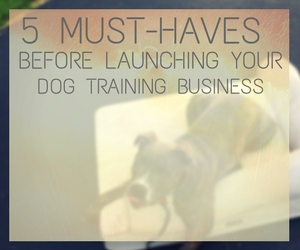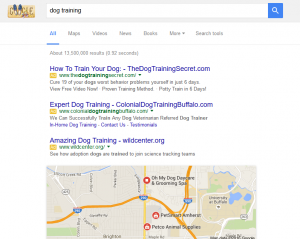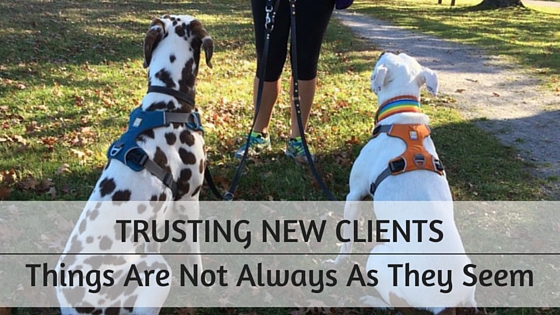![5 Must-Haves Before Launching Your Dog Training Business]()
by Ines | Dec 19, 2016 | Business
 When you’re first starting out on your own as a dog trainer you might not have all the right forms or documents created until you discover you need them. In this article, I’m going to point out some important and necessary documents you should have ready before you start taking on new clients.
When you’re first starting out on your own as a dog trainer you might not have all the right forms or documents created until you discover you need them. In this article, I’m going to point out some important and necessary documents you should have ready before you start taking on new clients.
1. In-Depth New Client Intake Form
Intake forms ensure you’re aware of the entire situation before taking on a new client. Having an intake form that dives into even the most minor details can help you create a more detailed training program or behavior modification program and may bring out some details about the dog that the owner may not find relevant to their training goals. As the professional, the more details you gather the better you can perform your job.
By gathering as much information as possible before you begin training, you can make the call as to what details about the situation or about the dog are relevant or irrelevant to the owner’s training goals.
Your new client intake form should ask questions about the dog’s diet, the dog’s past behavior history, the owner’s lifestyle, the dog’s medical history, and much more. Asking questions not only gives you a better understanding of the context of the dog’s behavior, but you just might spur some old memories from the client that may be unexpectedly relevant to the dog’s behavior changes or issues.
Related: 10 Customizable Dog Training Business Templates
2. New Client Welcome Packet
A new client welcome packet is a handout that explains what it’s like to work with a dog trainer, with your business, sets expectations, and sets up the (human) client to be successful as much as it does the dog. For many of your new clients, this will be their first time working with a dog trainer.
What can they expect from you with regards to instructions, communication, and follow-up? What is expected of them? What do you need from them to do your job well and reach their training goals?
A new client welcome packet explains all of this in detail so that they can be comfortable and aren’t left with a lot of questions. Giving your new clients a welcome packet helps you look professional and they’ll feel supported right from the start. Professionalism and customer experience are some of the best ways to differentiate yourself from your competition.
3. Client Lesson Overview Handout
Most trainers will follow up lessons with an email that briefly overviews what was taught in the lesson or they jot down notes on a blank piece of paper during the lesson. This can leave the client confused and important pieces of training information could be left out of the notes.
Instead, I recommend that you have a worksheet or handout that you fill out as you’re working with your clients. This kind of handout can include specific spaces to list management requirements, steps for breaking down complex behaviors and lists of rewards that that specific dog enjoys and will work for. This makes your notes easy for the client to read. Alternatively, you could even have the client fill this out during your lesson. This sets you and your (human) client up for success.
4. Specific Behavior Modification Assessment Forms
Taking on clients with leash reactivity, resource guarding, or separation anxiety? In addition to an in-depth intake form, you should have separate forms for each behavior issue that will require behavior modification. You shouldn’t ask clients with dogs with leash reactivity issues questions about separation anxiety and vice versa. (Unless, of course, their dog suffers from both.) Creating extra handouts centered around specific behavior issues will allow you to gather the right, detailed information from clients with specific challenges.
5. Follow Up Emails
Speedy correspondence is important for landing new clients. Making sure you have some emails you can quickly pull from and edit based on the prospect’s inquiry will save you time. Having a prepared email ready means you’ll also be less likely to forget critical information you’d want your potential client to know.
 Does this mean you copy/paste your email response without any kind of customization? No. You’ll still want to respond to any specific questions the prospect had or tell them that you understand their situation to start building a rapport with them, but having a template to pull from will make it easier for you to respond in a timely manner with all the right information they’ll need to begin working with you.
Does this mean you copy/paste your email response without any kind of customization? No. You’ll still want to respond to any specific questions the prospect had or tell them that you understand their situation to start building a rapport with them, but having a template to pull from will make it easier for you to respond in a timely manner with all the right information they’ll need to begin working with you.
I recommend you check out my New Dog Training Business Template Bundle that includes these five templates and five additional templates to give your business a major jump start. Each template can be completely customized to suit your branding and messaging. These templates and forms include the most relevant and important questions that the best professionals in our industry use all the time.
View The Template Bundle
Dog Training Business Tips
Receive valuable dog training business tips and resources right in your inbox! Subscribe to The Modern Dog Trainer now by submitting your name and email below. Don’t forget to let us know what you want to learn more about!
[mc4wp_form id=”2494″]
![5 Must-Haves Before Launching Your Dog Training Business]()
by Kat Camplin | Dec 13, 2016 | Business, Marketing

If you’ve spent any time on social media you’ve probably seen a hashtag. Each platform has its own hashtag culture, and some are better than others for growing engagement.
What is a Hashtag?
At its most basic, the hashtag acts like a preprogrammed search link. When you click it you are actually searching for multiple posts that have used that hashtag, whether you follow the person posting or not. The reverse is also true. If you post with a hashtag and someone clicks the link they will be able to see your post whether they follow you or not.
You can probably already see how you can grow followers and clients using hashtags. They allow you to reach new consumers.
There is a difference between a tag and a hashtag. A tag is mentioning another person or corporation or account on the social media platform you’re using. A hashtag is a sentence or sentiment in a string of words following a pound or hash sign: #.
Where can I use hashtags?
While Facebook allows you to use hashtags and have them work, they sort of counteract the privacy settings most users use on their personal accounts. In order for a hashtag to be seen outside your friends list the post has to be viewable by the public, which means changing your privacy settings or using them on your business page. However, studies show that hashtags on Facebook do not increase engagement, so best to spend time on other platforms. (Check out this eBook on Facebook Marketing Strategies to get the most out of that platform.)
Hashtags work on Facebook, Twitter, Instagram, Youtube, Pinterest, and Google+. Choose one or two platforms to play with hashtags at first, otherwise it can be overwhelming. For instance Instagram adds “of instagram” to a lot of the hashtags. While Twitter might use #DeafDogs, Instagram will use #DeafDogsofInstagram. Spend some time searching for hashtags on your platforms and see how people are using them there.
Be sure not to overdo it. Hashtag soup is difficult to read and it can be confusing what conversation you’re joining. One or two hashtags is enough.
Let’s set some goals.
Promoting your own business. Promoting a cause or charity or sentiment. Promoting another entity like a school or member organization or corporation. The first two are probably self explanatory. Why would you want to promote an entity other than yourself? Because chances are pretty good that entity will retweet or share your post to their followers, getting you new followers.
Ways to use hashtags.
1. Get involved in an existing hashtag campaign.
National Day / Month campaigns are a great way to reach beyond your existing followers. Using hashtags like : #NationalPetDay or #AdoptADogMonth. APDT does their Train Your Dog Month in January. For 2017 they are promoting the hashtag #APDTTrainYourDogMonth2017.
You could post photos of classes, photos of training, posts promoting group classes, etc. and add the hashtag and join in the campaign to promote dog training.
Other events include AKC championships, national dog shows, learning and science conferences and webinars.
2. Create your own hashtag contest.
Photo contests are a tried and successful way to promote your business. That said, you’ll have a lot of competition in this arena. The idea is to promote a contest that participants can only join by using a hashtag. You can have entries use your business hashtag or something unique. #MyBusinessPhotoContest might get the job done, but if you want to think broader you might target your city location #AtlantaTrainMyDog or #AtlantaFreeGroupClass. You could target a type or breed of dog #TinyDogsAreAwesome or #PittiesAreAwesomeContest. Use your imagination and spend some time promoting the contest on your web page and social media channels for a few weeks before the contest begins.
3. Hashtag your location.
“Registration for Group Dog Classes in #Cincinnati starting today! Check it out!” And add a link to your registration page. In theory, you could also add a hashtag for #dog, however, remember the hashtag is a link to a preprogrammed search page, which means #dog and #dogs are two different searches. If you’re going to add a second hashtag you might need a few variants so you hit both result pages.
4. Hashtag for retweets.
This one is quite variable, so sit down and ponder a bit. Photos and positive mentions are more likely to be retweeted and shared.
An easy example of this one would be to post a photo of a team passing the Canine Good Citizen test. Along with the photo is “Congratulations to Riley on passing his #AKCCGC test! @AKCDogLovers” This one uses a variant of the CGC hashtag and tags the official AKC account. AKC retweets quite a few of these, so you have a good chance of getting shared with all of their followers. There are variations of the #CGC hashtag, #CGC, #CanineGoodCitizen, #AKCCanineGoodCitizen, etc. Do a search or two before posting. The higher tests can be more confusing, #AKCACGC or #AKCAdvancedCGC or #AKCAdvancedCanineGoodCitizen. Again, do some search and see which one has the most recent usage.
Another example would be to tag or hashtag a company which produces products you use and like. “Check out Riley rocking his #BalanceHarness and loose leash walking in class!” “Riley thinks peanut butter and #Kongs are a perfect match! @Kong” “Riley drools for the entire 3 minutes it takes to make @HonestKitchen #Zeal.”
You get the idea. The point of this one is to support those products you like by helping to promote them. Depending on whether or not they have a social media person that’s on the ball, your post may be shared or not. Give a tag or product hashtag a few a tries. If your post isn’t shared then move onto another entity to promote.
One of the easier ways to do this is to simply share posts from organizations. A share / retweet may get you a few “likes” and followers.
5. Promoting a cause or sentiment.
These usually have their own hashtags, but followers are loyal to these niche markets so some research on your part may be needed. #PibbleLove, #Tripawds, #DeafDogs #WhoAdoptedWho #RescuedDogsofInstagram are causes and sentiments you can use on social media. Do some searches of some of your favorite types of dogs to work with, some charities you like, some causes you support and make note of the hashtags they are using. This can be being part of a much bigger conversation, but your existing followers will get to see what you care about, what you promote, and that’s a good reason to hire you. You care.
A Few Final Hashtag Rules
- Keep hashtags short. 20 characters should be the max.
- Keep spelling accurate. Remember that things like contests may be passed verbally, so keep it “positive” not “pawsitive.”
- If you don’t know what a hashtag is saying, don’t use it. You’ll see a lot of “trending” hashtags which are usually used for causes or sentiments. If you don’t know what it’s for either research it or don’t use it. Pushback for hijacking a hashtag is pretty brutal
- Use tags and hashtags sparingly by switching between posts that use them and that don’t use them.
- Join existing conversations. Participation goes both ways. If you’re just posting and not participating you probably won’t get very far. Share, reply, and comment on posts you like.
- Be cautious of participating in political and religious causes.
Resources
RiteTag has a free search to check on how certain hashtags are doing. In-depth reports require a subscription, but the free version should get you started.
Dog Training Topic Calendar & Business Tips
Subscribe to The Modern Dog Trainer Blog to get our monthly dog training topic calendar for social media or blogging ideas. The calendar shows “National Month” and “National Days” so you can use those hashtags in your planning.
Don’t forget to let us know what you want to learn more about in the form below!
[mc4wp_form id=”2494″]
![5 Must-Haves Before Launching Your Dog Training Business]()
by TMDT Team | Dec 8, 2016 | Business
This is a guest article by Molly Sumner CDBC, CPDT-KSA, CFE. Molly is a professional dog trainer and behavior consultant as well as a certified compassion fatigue educator. Her passion for dog training doesn’t stop at clients and their dogs but also extends to her fellow colleagues. Molly sees the personal drain that caring so deeply for animals can have on professionals so she’s graciously agreed to share some helpful tips to prevent burnout and compassion fatigue.
Molly just appeared as a guest on our podcast for Episode 10 Molly Sumridge on Compassion Fatigue in Pet Professionals. Listen in to learn about the differences between compassion fatigue and burnout and the symptoms to look out for!

2017 is less than a month away. December is usually quite hectic with the holidays, up and down schedules, commitments and gatherings, and the cold or flu trying to take over the minute we feel worn out. It is easy for the month to blow through and next thing you know it’s January, the year is over and you’re left with the new year stretched out in front of you with little to no guidance on what to make of it.
Don’t let December consume you. And don’t miss out on creating a plan for the new year that will set you up for major success and happiness in the new year. Even if you read this after the new year, it’s not too late to set yourself up to have one of the best years of your life both personally and professionally. I write and speak a lot on compassion fatigue and burnout, and truth be told, most of the professionals I meet are struggling in some way or another. But making a few changes in our lives we can significantly change how we feel and in response, can propel us to some very exciting and successful outcomes.
Here are 10 (YES 10!) tips to make 2017 your best year while staving off burnout and compassion fatigue.
1. Goal Setting
New Year’s Resolutions statistically speaking – FAIL. But actual attainable goal setting can be successful if you do it right. Goal setting using the SMART system can be very effective. Make sure any changes you want to make to your life are: S – specific, M – measurable, A – assignable, R – realistic, T – time-bound. There are many goal setting systems. Pick one that resonates with you, dedicate a week to work on the process and then commit to seeing it through with weekly, monthly, and quarterly check ins.
2. Contact Boundaries
The hard truth is, your business will not fail if you don’t reply to that message immediately. In fact, the opposite is true. The more you are accessible to your clients, the more likely you are to give bad advice, create scheduling errors, and become burned out or compassion fatigued. Spend a week or two designing a contact schedule where people can reach you or you will respond to their messages. This should include email, phone, text messages and any other communication portal your clients use to reach you. Have designated “no contact” times where you will not check your email or messages and will not answer. Consider leaving your device in a space away from you during that time so you can be completely focused on yourself, a task or your loved ones. You’ll be happier and healthier for it.
3. Conquer the Email Monster
How many emails are sitting in your inbox? 20, 50, 300? Clean it out and create a system for filing messages. An even better solution is a program like Boomerang that can move emails in and out of your inbox based on your availability and remind you when someone has failed to reply to a message. For more on beating the email blues, check out my blog on the topic.
4. Express Gratitude
Positive Psychology studies have shown that practicing gratitude changes how your brain filters the world. By focusing on the good things we have, our brain finds new opportunities for us. The opposite applies too. If we focus on the negative, our brain only filters in more problems. So turn the dial to success. On a piece of paper, list 5 things you’re grateful for. Do this daily. After a week or so, the information your brain picks up will start to change.
5. Talk to Yourself
Now I don’t mean out loud, in a crowded space, without at least some kind of Bluetooth in your ear. This that case it’s fine. But really what I mean is taking a moment and asking yourself how you’re feeling. After that, asking yourself what is causing those feelings. And from there asking yourself what might help encourage or discourage those feelings. Cognitive-behavioral psychology teaches us that we have much more control over how we feel than we think we do. This is also the basis for beginning a mindfulness practice. It really is that simple.
6. Celebrate – YOU!
It is likely you will spend some part of the end of the year celebrating a birthday, at a holiday party, or some other social celebration, but how often do you celebrate you? I don’t just mean on your birthday either. Celebrating yourself meaning taking stock of your accomplishments, big or small, whatever matters to you – and only you – and honoring them. The celebration could take many forms. It could be as simple as writing them down to acknowledge them. Or it could be as big as having a get-together or a meal to celebrate. The size of the act does not matter. It is the acknowledgment that matters. Ignoring our accomplishments defeats us and leaves us feeling resentful of our world. It inevitably will hold you back. Don’t feel guilty celebrating yourself – you deserve it!
7. Pay it Forward
Expressing gratitude to another is powerful for the giver and the receiver. Generally, our best clients come from personal referrals. 88% of consumers trust online reviews as much as personal recommendations. So share the love. Leave positive reviews on people’s business websites or offer to write a testimonial. Leave positive feedback on receipts. This feedback releases happy chemicals in both the receiver and the giver – it’s a win for all!
8. Get Moving
Agility doesn’t count. Seriously, though, with the long hours you put into your business I’m guessing you don’t get out much, but moving is some important to physical and mental health. Try something simple if you don’t move around much, such as a short walk around the block, or even just 2-3 extra trips of the stairs or back and forth to the car. For you over achievers (you know who you are), try a yoga class, crossfit, a morning bootcamp, or a class at the YMCA. Anything to get your heart going just a little faster once a day will change your life.
9. Get Out of Your Box
If you’re like me, your life revolves around people and dogs with little room for anything non-animal related. Any activity that is out of this realm can feel weird or uncomfortable. But it is so important to escape once in awhile. Try a group class in something you know little about. Go to a lecture, concert, or play. Driven to make a difference? Volunteer to help at a food pantry, meals on wheels, habit for humanity etc. You don’t have pick something you feel a connection to either. It is about getting out of the norm and trying something new. It is good for the brain, opens up your social circles, and breathes fresh air into your life. It might even connect you with future opportunities you’ve never even dreamt of.
10. Take 10
I get it, you’re busy. I am too. After writing this I have a webinar to attend and a client to go see. But I am also “Taking 10”. I am taking 10 minutes to do something that heals and helps me. It could be meditation, reading a book, journaling, being spiritual, coloring, cooking a meal or just breathing. What it won’t be is time on social media, answering emails, or interacting with anyone or anything. It is 10 minutes of solitude. If you think that’s too much, or too hard – you need 20! But start with 10.
If you only do one thing on this list let it be the last one. Then work on the rest. Your industry needs you. The world needs you. Take care of yourself in a meaningful way so that you can be there for all those who need you. Self-care isn’t selfish. Let’s make 2017 an awesome year, by focusing inward and then letting our light sign. For more help and suggestions, visit: http://www.mollysumridge.com/
Molly Sumner CDBC, CPDT-KSA, CFE, is a professional dog trainer and behavior consultant as well as a certified compassion fatigue educator. Her passion for dog training doesn’t stop at clients and their dogs but also extends to her fellow colleagues. Molly sees the personal drain that caring so deeply for animals can have on professionals. She has dedicated a significant part of her career to learning about how to help her colleagues better their business and themselves. In addition to her dog training education, she is also a QPR Gatekeeper and Online Suicide Prevention Specialist.
Dog Training Business Tips
Receive valuable dog training business tips and resources right in your inbox! Subscribe to The Modern Dog Trainer now by submitting your name and email below. Don’t forget to let us know what you want to learn more about!
[mc4wp_form id=”2494″]
![5 Must-Haves Before Launching Your Dog Training Business]()
by Ines | Jul 25, 2016 | Business
 Income can become seasonal as holidays and vacations affect your clients’ ability and availability to train their dogs. Additionally, the worst situation dog trainers put themselves in is always having to get new clients in the door to make a living. That is the hardest sale to make! However, there are some steps you can take to make income more continuous and steady throughout the year.
Income can become seasonal as holidays and vacations affect your clients’ ability and availability to train their dogs. Additionally, the worst situation dog trainers put themselves in is always having to get new clients in the door to make a living. That is the hardest sale to make! However, there are some steps you can take to make income more continuous and steady throughout the year.
Fortunately, there are some steps you can take to make income more continuous and steady throughout the year as a dog trainer.
Offer Day Training And Board & Train Programs
Day training is when the trainer comes to the house during the day to work with the dog one-on-one without the owner. Many clients are grateful to have you come in and help them with training because their lives are already so hectic. During vacation seasons, people often look to board their dogs while they are away so give them an even better option – boarding and training while they are away. These programs are often accompanied by private lessons to ensure training transfers smoothly to the owner.
Partner With Apartment Complexes
Apartment complexes are always looking for a way to offer competitive benefits. Consider partnering up with a local complex by teaching weekly classes for their residents only. Explain to the management that better-trained dogs and a sense of community will increase their value and create a more peaceful living environment for their residents. If you partner up and offer weekly, open-enrollment classes then this is a great avenue to continuous income throughout the year.
Recurring Refresher Classes
As professionals, we know training never stops. However, many clients have trouble continuing the training long term. Offer a monthly or bi-weekly class for previous class graduates to pop in for a class with a monthly subscription. Consider adding a rule such as “you must attend 10/12 months a year in order to maintain eligibility to attend these refresher classes.” This creates dedicated clients, a sense of community among the clients, and better behaved dogs as the end result.
What are some ways you or others make consistent income throughout the year?
Dog Training Business Tips
Receive valuable dog training business tips and resources right in your inbox! Subscribe to The Modern Dog Trainer now by submitting your name and email below. Don’t forget to let us know what you want to learn more about!
[mc4wp_form]
![5 Must-Haves Before Launching Your Dog Training Business]()
by Ines | May 9, 2016 | Business

Mistakes You’re Making When Marketing Your Dog Training Business
1. You Pay for Yelp Ads
I’m pretty sure that every business owner in North America has received calls from Yelp to advertise. At first, its seems like a great option because potential customers often check Yelp reviews before calling you. For dog trainers, however, you’re better off spending your marketing budget on Google rather than Yelp.
From my experience, people visiting Yelp already have a trainer in mind and are looking at their reviews for confirmation. On Yelp, your ads may cost more and may not be as targeted as they could be on Google Adwords. Additionally, as Google has introduced their own review systems, Yelp has seen a decline in search rankings within Google.
Yelp is not to be neglected, however. Ensuring you have consistent, positive reviews will encourage potential customers who are doing their research to decide on your business to satisfy their needs. Always remind current and past clients to leave their reviews there or on your Google business page.
Recommended Reading: Why You Should Do Some Market Research Before Starting Your Dog Training Business
2. You Have a Website, But Don’t Know How It Performs in Google
This is common among dog trainers. We all know a website is important, but many don’t quite realize why they’re important. Your website isn’t just a place for potential customers to learn about you before hiring you. Your website is critical to your business’s success. A dog trainer’s website should have a professional feel and should work to get you new clients by getting indexed by Google, showing potential clients your expertise, demonstrating to clients how you can help them in their situation, and making it easy to reach out to you.
If your website is not connected to Google Analytics, you’re missing out on a lot of intelligence about how people navigate to and through your website. If you think you’re all set because you have a website, you’re missing the point of having one in the first place.
An established website should provide you with a wealth of information about your potential clients and is critical to long-term, consistent success as a dog trainer. Your website is one of the best ways prospective clients can find out about you.
3. You’re Considering Paying for Facebook Ads
There’s a right way and a wrong way to advertise on Facebook. If you’re looking to build awareness of your brand or an upcoming event, Facebook is a great way to promote those. However, if you’re trying to fill up a group class by the end of the month, you’re better off advertising on Google which is where people intend to make purchasing decisions.
4. You’re Hoping that Business Cards at a Local Shop Will Generate Interest
If you leave anything at a store in hopes to generate interest in your services, think about what the customer might be interested in reading about. Based on the visitor’s reason for visiting the store and the services you offer, make a flyer, brochure, or hand out that mixes the two together.
Let’s use a pet store for an example. Customers visiting the pet store are most likely there to purchase dog food or dog toys. In this instance, I’d recommend a handout on dog nutrition, best toys to keep dogs busy, or even the benefits of food puzzle toys for dogs. With a catchy title and engaging images, your handout will attract readers. The information you share will demonstrate your knowledge and you’ll have provided value to the reader. The goal is that the reader will think of you the next time they have a training related question. A simple business card just doesn’t cut it anymore.
5. Avoiding Google Adwords Because You’re Scared to Spend Too Much Money
 Don’t get me wrong, that is a legitimate concern. Google Adwords can easily take your money and run with it, but being scared of Adwords is not a good excuse. Many successful dog trainers, if not most, use Google Adwords to consistently fill their classes and schedule with new clients. Learning how to target audiences strategically can save you money and bring you new clients on a regular basis. It is definitely worth the time investment to learn how to use Google Adwords if you want to have a successful dog training business.
Don’t get me wrong, that is a legitimate concern. Google Adwords can easily take your money and run with it, but being scared of Adwords is not a good excuse. Many successful dog trainers, if not most, use Google Adwords to consistently fill their classes and schedule with new clients. Learning how to target audiences strategically can save you money and bring you new clients on a regular basis. It is definitely worth the time investment to learn how to use Google Adwords if you want to have a successful dog training business.
6. Your Website Doesn’t Have a Purpose or Goal
You know your website is where potential customers go to learn about you. However, have you thought about:
- Is your website easy to navigate?
- Can visitors easily contact you from every page?
- Does your website load quickly on all devices?
- Does your site acknowledge your visitor’s concerns, situation, or objections?
If you’ve forgotten to ask these questions, your website isn’t doing as well as it could be.
7. You’re Forgetting About Your Current or Past Customers
Current or past customers are your greatest resources. It is easier to market to current or past customers than finding new customers. If you don’t have an option for recurring services for your clients, you’re missing out on a huge opportunity and you’re leaving your clients hanging without continued support. Chances are you have several customers who would love an opportunity to continue working with you if you gave them the option.
Ideally, you’ll want to start an email newsletter to keep customers engaged and share new services. Additionally, you want to be top of their mind when their friends mention dog behavior struggles, right?
8. You’re Advertising, Not Marketing
Raise your hand if you like ads online, on TV, or on the radio.
Don’t interrupt people’s lives with pushy advertising. Enough said.
(Check out this eBook on Facebook Marketing Strategies to get the most out of that platform.)
9. You’re Not Demonstrating Your Expertise
A key component to marketing your dog training business is demonstrating your ability to satisfy customers. Testimonials and case studies with images and videos can be impactful. Watching a video testimonial can help someone who’s on the fence about calling you make the decision to reach out.
You can spend a great deal in marketing, but testimonials and case studies can truly seal the deal and help you get new clients. Detailed and structured case studies can be distributed along with other marketing materials to local veterinarians to demonstrate your professionalism and expertise.
10. You Don’t Realize Why People Hire Dog Trainers
What truly drives people to contact a dog trainer? Their dog’s behavior? Nope.
People reach out to dog trainers because their quality of life is suffering. They don’t want to give up on their dog, but they also know they don’t want to continue living the way they are now. Your messaging should address how you’re planning on relieving them of stress, anxiety, and improving their quality of life. It isn’t enough to spout out a message about positive dog training, you must make them confident in your ability to improve their current situation.
Digital Marketing Solutions for Dog Trainers
Digital marketing isn’t a gimmick. I work with professional and amateur dog trainers to bring their businesses up to speed with the goal of generating consistent income. As a dog trainer myself, I’ve experienced the ups and downs of seasonal clientele. I’ve learned digital marketing solutions the hard way and now I’m helping other dog trainers grow their businesses, too.
Let’s see how we can grow your dog training business to the next level. Whether you’re going from part-time to full-time or simply want to get new clients more consistently each month, you can benefit from a course I’m working on.
Check out the courses I’m producing to help dog trainers start and grow their businesses.
![5 Must-Haves Before Launching Your Dog Training Business]()
by Erin Bessey | Apr 9, 2016 | Business
One of the best referrals for a dog trainer is a veterinarian. They are the first ones to see the puppy at 8 weeks, sooner if a breeder brings a litter into the office for a health exam. The veterinarian will discuss the importance of socialization and starting young with training but sometimes the conversation stops there. The client is left to search all the listings for a dog trainer in their area. So what do you do to get those referrals? Drop off some business cards and brochures and hope the referrals start coming?

Image via Bessey’s Positive Paws
I am in a unique position as I am a dog trainer and I work in a veterinary office. Removing myself from the training position, here’s what I have seen for successfully establishing a relationship with veterinarians and their staff.
Go to the office in person! If the vet clinics are within driving distance, take the time and deliver the material (cards, brochures, packets, etc.) in person. Block off a day dedicated to making these deliveries and call ahead to try and schedule a meet and greet. Not that this speaks for all clinics but when packets were received from trainers, boarding kennels, groomers, etc. they were read and then placed aside and often forgot about. The business cards might get placed on the bulletin board but there was no relationship established with the staff to make it personal. The referrals might be given but without enthusiasm and often a list is provided, once again, leaving it to the client to sort through and decide which one is best.
When you go to the clinic in person, you are being interviewed. Discuss with anyone who is available your training techniques, method, and position on training. If they work at a vet clinic chances are they have a pet or two of their own. Offer some tips to help them with any issues they might mention their pet has. This shows them you are easy to talk to and that you have valuable information to help them. Be open to any and all questions that they have. At the end of your meet and greet you then leave them with the material you would have otherwise mailed to them for them to review and have available to their clients.
Now that the clinic has had a positive experience with you as a trainer, your brochures and business cards aren’t just pieces of paper anymore, they are a visible reminder and representation of you, the person they met.
If you are unable to go in person, call ahead and ask if you can mail along some material for them to display. If you have brochures send along a brochure stand; don’t assume they will have one empty and available to fill. Get the name of the person you spoke to when you called to inquire about sending along information and put a friendly note inside and use the persons name, “I spoke with Jane the other day on the phone…” – anything to make it more personal. Ask them to follow up if they have any questions, or better yet, let them know you will follow up in a few days to see if they received it and have any questions.
If you use an intake sheets for clients have a space available for them to let you know how they found you. Did someone refer them? The vet? If so who and/or which vet clinic? Then encourage them to tell the vet if they are happy with your services. Word of mouth is power! If clients start to rave about you it will speak volumes to the veterinarians and other staff members.
Lastly, don’t forget to thank the veterinary clinic for any referrals. You can do this once a year, twice a year or quarterly. How often may depend on how many referrals are being pushed your way. Bring by a thank you card and maybe something tasty, since we know food can be a powerful motivator. Again, delivering in person is always best because you become a familiar, friendly face, and you continue to establish and build the relationship with the staff.
How have you established a relationship with local veterinarians?
![5 Must-Haves Before Launching Your Dog Training Business]()
by Erin Bessey | Mar 28, 2016 | Business, Training Methods
Everyone loves good puppy classes. Cute, fluffy, little bundles of fur with their stinky breath and corn chip smelling feet. Most students come to class already having begun the basic behaviors. While those are important and key to any dog training class here are a few training games to incorporate into class to strengthen those basic behaviors while having fun.

Image via Bessey’s Positive Paws
5 Fun Games to Play During Puppy Classes
Crazy to Calm
When the bait bag and clicker come out those puppies line right up in front of their owners and pay close attention to what is being asked. They stay calm and attentive and excel at learning behaviors. What’s happening though, is that the pups aren’t learning how to still do those behaviors when they are amped up. Crazy to calm does just that. Play with the puppy for a set amount of time, jazzing them up to a level where they are rowdy but not completely out of control. After the time is up, stop playing and wait for the pup to calm down and ideally offer a sit. It is okay when your puppy is new to this game to cue them to sit the first few times but ultimately we want them to be able to offer it on their own. If we cue too much our dogs begin to rely on us to tell them what to do in any given situation, whereas when we allow them to offer the behavior it becomes more reliable.
Once your puppy is calm and sitting you will continue to reward your pup for staying put. Then you will release him with “Free.” Always remember to release your puppy when done. Crazy to calm will help teach impulse control, stay, and how to quickly calm themselves in excitable situations.
Puppy Ping Pong
Majority of owners will prioritize the behaviors they want their puppy to learn with coming when called being first, if not second to walking on leash. Puppy ping pong is a great game to play to build a knee jerk reaction to hearing their name and running towards their owner. The game can include 2 or more people. Each person will have a handful of delicious meaty high value treats. One at a time someone will call the puppy, be very exciting and happy to encourage the puppy to run fast towards them. Once the puppy reaches the person calling they will touch the dog’s collar and then reward with the meaty treat. Encourage clients to give 1 to 3 treats, one at a time to avoid having a puppy dine and dash (knowing they will only receive one treat, grab it and run off to the next person). Stress the importance of being able to touch the dog’s collar because it can save the dogs life. A recall is no good if you can’t actually get a hold of the dog if you are alongside a busy road.
Have another person call the puppy and reward the same way. The puppy will run back and forth between the people playing learning that coming when called results in fun and that he gets delicious stinky treats.
Catch Me If You Can
Another game to strengthen the recall and to help with leash walking. When a puppy has something he shouldn’t or doesn’t come when we call, we move towards him to get him. With a puppy this often prompts a fun game of chase. How extremely annoying for the owner. Catch Me If You Can turns the table on the puppy and teaches him it is more fun to catch up to us than to be pursued. In a safe space or with your puppy on leash move away from him encouraging him to follow you. When he moves in your direction you stop, let him catch you, mark it and reward with high value treats. While the puppy is eating the treat move away again in another direction, encourage him to move after you. Mark and treat. The point of stopping before the puppy actually catches up is to prevent having a puppy bite at pant legs or jump at the person running.
Pass the Puppy
Who doesn’t love to cuddle a puppy. Have the trainer take one puppy away from their owner. Have the person who is without a puppy move and take the puppy to their right and so on until everyone has someone else’s puppy. Pass the puppy is great for socializing the puppy and have them get used to other people handling them in a positive environment. People handling can ask for a simple behavior, give treats and just play.
Hide and Seek
If you have equipment in the training room or places where the owner can go out of sight, hide and seek is a good game to play to help with recalls. This game teaches dogs that they need to listen to their handlers as much as look for them. It encourages owners to stay upbeat and pushes their dogs to find them because recalls aren’t always as easy as saying “Come” and then quietly standing by for the dog to find them.
I like to remind clients that everything we teach our puppy is a trick but to us we take some more serious than others. Playing these games will help take those serious behaviors and keep them fun for us and our pups and make them strong, reliable behaviors.
Do you have other games you play in puppy classes?
Dog Training Business Tips
Receive valuable dog training business tips and resources right in your inbox! Subscribe to The Modern Dog Trainer now by submitting your name and email below. Don’t forget to let us know what you want to learn more about!
[mc4wp_form]
![5 Must-Haves Before Launching Your Dog Training Business]()
by Thomas Aaron | Feb 20, 2016 | Business, Training Methods

It is a story often told among dog trainers. It goes something like this:
A prospective client calls and says that another dog trainer – sometimes multiple dog trainers – could not help their dog or said their dog was beyond help. We take the case and find that the dog is indeed help-able. In fact, we do wonders with the dog in a short period of time, and we are perplexed and discouraged that the other trainer (or trainers) almost destroyed the client’s hope for their pet, when in fact the case really was not that difficult.
Recommended Reading: The Importance of Asking the Right Questions to New Dog Training Clients
When we take such cases and succeed in helping a dog, there is a part of us that feels superior – that other trainers in our area are not as capable as we are. Frankly, it feels kind of good, and we can’t wait to herald the news to our other colleagues so that they can be wary of the incompetent, unhelpful trainers who nearly destroyed some pup’s life.
All is well that ends well, right? The dog received the help it needed. The client is happy. We feel more confident than ever. But there often is another side to such stories.
Taking Client’s Comments With A Grain Of Salt
Perhaps the client was indeed telling the truth about the other trainer(s). But stories about multiple trainers failing cause me to be suspicious of the client – especially if my impression is that the dog’s problems are easily remedied.
We need to consider that clients may not always be truthful. They are human (like us), and sometimes they are not above behaving in a way that gets them what they want or makes them feel good (like their dogs).
A case in point: I recently was approached by a prospective client who told me that one of my most trusted colleagues and referral partners had recommended my board-and-train program. According to this client, my colleague thought it would be a better option for this particular dog than her own group class.
When I called my colleague to thank her, I learned the prospective client was lying. In fact, my colleague had this client on the roster for an upcoming, limited-size group class and had no idea the client was still shopping around for trainers.
When questioned about the situation, the prospective client began back-pedaling and telling me more lies to extricate herself from the first one. I decided not to accept this person as a client. If she was willing to blatantly lie to me (she could have just said they would rather do a board-and-train program), then what would she have been capable of unjustly saying about ME? It just didn’t seem worth the risk.
Digging For The Truth
As a rule, when a potential client tells me they have worked with one or more trainers, I require them to tell me who the trainers were, what steps were taken to solve a dog’s behavior issues, and how the dog responded to those steps. (And if I personally know one or more of the trainers mentioned, I might call them to better understand their experience with the client and dog.) If the prospective client is not willing to be forthcoming with such information – or if the information they provide throws up red flags about their own credibility or willingness to follow through with a trainer’s advice – I am better off without them.
Give Colleagues The Benefit Of The Doubt
Professionally speaking, I think it is a bad idea to give credence to unverified testimony against colleagues. Doing so risks us forming (or worse, spreading) false conclusions about them, and it potentially burdens us with deceitful or non-compliant clients. There are two sides to every story, and if we are to make a judgement about the credibility of a prospective client or the professionalism of a colleague, it is only right to get all the pertinent details and understand both sides of the story.
My mission as a professional dog trainer is helping dogs, but sometimes owners need help too. And sometimes helping an owner is showing them that some behaviors are rewarding, whereas others are not.
Have you ever had a similar experience?
Dog Training Business Tips
Receive valuable dog training business tips and resources right in your inbox! Subscribe to The Modern Dog Trainer now by submitting your name and email below. Don’t forget to let us know what you want to learn more about!
![5 Must-Haves Before Launching Your Dog Training Business]()
by Erin Bessey | Jan 18, 2016 | Business, Training Methods
Welcome 2016! Traditionally people begin thinking of their New Year’s Resolutions shortly after the start of the new year, maybe a week or two before. While there are the common, personal New Year’s Resolutions – eat healthy, exercise more – what about your resolutions as a dog trainer? What have you resolved to do? How are you going to better yourself and your business this year? We are already half way through January and if you haven’t come up with any resolutions we’ve got you covered.

Image via Erin Bessey – Bessey’s Positive Paws
10 New Year’s Resolutions
Increase Clientele
Review your clientele numbers for the last year or two. Then figure out how much you would like to grow this year and set a goal to increase those numbers for 2016.
Network More
Maybe you are just starting out in your business, perhaps you are well established, whichever you are make a point to reach out to others. We can fall into patterns easily and get comfortable there. You won’t be able to grow if you don’t push those comfort levels. Reach out to other trainers, veterinarians, groomers, boarding and daycare facilities. Those are the traditional places to network. What about thinking outside the box? Look to speaking with schools or children’s daycare. While this may seem odd, these places have great, continuous interactions with families. Families who like to share stories about their kids and the family pet. Maybe the daycare is run in a home and has a dog that is present. Putting your name out there and talking to some office people is all it would take. Your name could spread like wildfire because who else would think to make themselves known at a non dog-related business?
Earn Certifications
This is the year to get certified or get more memberships! Sign up for the test (if required) to commit yourself to becoming certified and then start studying. There’s no better way to set yourself apart from others than to have obtained a few certifications. Certification of Professional Dog Trainers, Karen Pryor Academy, International Association of Behavior Consultants are just a few to look into.
Raise The Rates
If it has been a number of years and you are still maintaining the initial starting rate it might be time to increase. The business is growing and it is important to stay competitive with the surrounding areas while being paid your worth.
Train Your Own Dog
As a trainer we get very fixated on our work. Why wouldn’t we? We love what we do, but because we are busy helping others train their dogs our personal pets often fall to the way side. Make one of your new year’s resolutions to teach your dog a new trick or activity.
Teach A New Class
If you haven’t given your classes a face lift in a while make it happen this year. Have you just updated the current class curriculum? Why not look into offering a new class.
Learn A New Skill
The dog training world is exploding with all kinds of training. If you are used to teaching basic behavior classes take the time, reach outside of your comfort zone and learn something new. If you have never done agility, find a class and try it out with your own dog or better yet, build your own equipment. Interested in doing a trick class? Teach your dog the trick first before offering it to others. You would accomplish two resolutions on your list doing it this way! Try any one of the following: Treiball, heel work, Rally-o, agility, dog sports, trick training, nose work, and the list goes on!
Read More Books
In order to learn a new skill it may require you to read a new book to accomplish that. Challenge yourself and read a book that you don’t necessarily agree with as far as training techniques. Exercise your mind and form opinions and arguments and be sure to be able to back up your position. How many dog training books did you read last year? Can you do better?
Set A Schedule
It can be tough setting a schedule and sticking to it. Dog trainers want to help owners and their dogs as much as they can and go to great lengths to do this. Making time when we wouldn’t otherwise be scheduling due to fear of losing a potential client isn’t always best. Being too flexible could indicate to clients business is slow. Avoid answering e-mails and phone calls at all hours. Instead have a shut off time where you are done work for the day. Set a schedule if you don’t have one and stick to it.
Make Time To Play
Make time for yourself! To avoid burn out you need to be sure to leave time for yourself to play. This is where setting a schedule as one of the new year’s resolutions will be helpful. Play might be considered learning a new skill or working with your own dog but be sure to leave time to do something for you. It’s okay to do that!
What new year’s resolutions have you made? Comment below and let us know.
Sign up below to stay up to date with modern dog training business practices and dog training methods!
Dog Training Business Tips
Receive valuable dog training business tips and resources right in your inbox! Subscribe to The Modern Dog Trainer now by submitting your name and email below. Don’t forget to let us know what you want to learn more about!
[mc4wp_form]
![5 Must-Haves Before Launching Your Dog Training Business]()
by Laurie Schlossnagle | Jan 12, 2016 | Business, Training Methods
What Is Continuing Education?
In a quick, unscientific poll of a small number of colleagues and clients, the overwhelming results were that clients appreciate knowing their trainers are participating in hands-on continuing education. To be among the best of the best in the dog training field, it is important to also be a student. Some certifications for dog trainers require continuing education to maintain certification; some dog trainers choose to participate in continuing education.

Continuing education can take on many forms. It can be a book that is read, a dvd that is watched, a seminar that is observed, a local workshop that is hands-on, a national conference that is all of the above with the added bonus of networking with colleagues. While a list of books read and dvds watched can be impressive, spending time and funds on a seminar, workshop, and/or conference shows clients a different level of commitment to continuing education – a level of investment both of time and funds to seek out knowledge and information.
Recommended Reading: Top 10 Dog Training Conferences for 2017
Why Is Continuing Education Important For Dog Trainers?
Accountability – seeking out and participating in continuing education puts a trainer into the position of being a student and demonstrating results.
Commitment – commitment to our profession, commitment to our clients, commitment to our dogs. Attending workshops, seminars, classes, etc. sparks a renewed commitment to spend time doing what we love.
Maintenance of/increasing knowledge and skill – use it or lose it! Teaching helps us to maintain our knowledge and skill but continuing education helps us to increase that knowledge and skill. Learning about new thought processes and methods expands our range of who we can help and how we can help them.
Staying on the cutting edge – there is constantly new science about dogs, about learning, about humans, about the dog/human interaction, etc. Participating in continuing education keeps trainers up to date on the latest and greatest science and how it can be useful in dog training.
Related: Check out our “Mastermind Meetups for Modern Dog Trainers” and request one in your area!
Sign up below to stay up to date with modern dog training business practices and dog training methods!
Dog Training Business Tips
Receive valuable dog training business tips and resources right in your inbox! Subscribe to The Modern Dog Trainer now by submitting your name and email below. Don’t forget to let us know what you want to learn more about!
[mc4wp_form]
 When you’re first starting out on your own as a dog trainer you might not have all the right forms or documents created until you discover you need them. In this article, I’m going to point out some important and necessary documents you should have ready before you start taking on new clients.
When you’re first starting out on your own as a dog trainer you might not have all the right forms or documents created until you discover you need them. In this article, I’m going to point out some important and necessary documents you should have ready before you start taking on new clients. Does this mean you copy/paste your email response without any kind of customization? No. You’ll still want to respond to any specific questions the prospect had or tell them that you understand their situation to start building a rapport with them, but having a template to pull from will make it easier for you to respond in a timely manner with all the right information they’ll need to begin working with you.
Does this mean you copy/paste your email response without any kind of customization? No. You’ll still want to respond to any specific questions the prospect had or tell them that you understand their situation to start building a rapport with them, but having a template to pull from will make it easier for you to respond in a timely manner with all the right information they’ll need to begin working with you.


 Income can become seasonal as holidays and vacations affect your clients’ ability and availability to train their dogs. Additionally, the worst situation dog trainers put themselves in is always having to get new clients in the door to make a living. That is the hardest sale to make! However, there are some steps you can take to make income more continuous and steady throughout the year.
Income can become seasonal as holidays and vacations affect your clients’ ability and availability to train their dogs. Additionally, the worst situation dog trainers put themselves in is always having to get new clients in the door to make a living. That is the hardest sale to make! However, there are some steps you can take to make income more continuous and steady throughout the year.
 Don’t get me wrong, that is a legitimate concern. Google Adwords can easily take your money and run with it, but being scared of Adwords is not a good excuse. Many successful dog trainers, if not most, use Google Adwords to consistently fill their classes and schedule with new clients. Learning how to target audiences strategically can save you money and bring you new clients on a regular basis. It is definitely worth the time investment to learn how to use Google Adwords if you want to have a successful dog training business.
Don’t get me wrong, that is a legitimate concern. Google Adwords can easily take your money and run with it, but being scared of Adwords is not a good excuse. Many successful dog trainers, if not most, use Google Adwords to consistently fill their classes and schedule with new clients. Learning how to target audiences strategically can save you money and bring you new clients on a regular basis. It is definitely worth the time investment to learn how to use Google Adwords if you want to have a successful dog training business.






